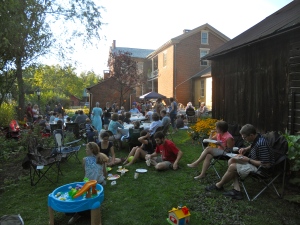What do Pineapple tomatoes, Goji fruit, and Pink Cadillac tomatoes have in common? All were experiments in my garden this summer.
The Pineapple tomatoes, heirlooms with golden fruit shot through with bursts of fiery red, were this year’s favorite. Prolific, tasty giants—one slice filled my sandwich, sometimes dripping out the sides. Yum.
Goji fruit, aka Lycium chinense or wolfberry, came with promises of health—everything from nurturing calmness and sleep, to promoting athletic prowess and weight loss, to slowing aging and preventing cancer. Ads for goji juice and dried goji berries say they’re chock full of amino acids, protein, and nutrients, in other words, a super food. Well, I’m going to add one more accolade: Pure entertainment.
Yes, I tasted more than a few of the scarlet, teardrop-shaped fruit trying to figure them out. When I pop one into my mouth, pressing it with my tongue against the roof of my mouth, there is a burst of juice with a touch of sweetness, followed by a slight bitterness. It tastes like something that should be good for you.
Back to the entertainment aspect…I potted my goji plant in a container on the deck where it joins other edibles—fig trees, alpine strawberries, cape gooseberries, nasturtiums, and a red raspberry plant called Raspberry Shortcake. The deck is off our living room, separated by a wall of windows about 9 feet tall. Quiet a view. And this summer, I was fortunate enough to watch a cardinal couple nip and peck and gobble the goji berries, delicately dangling from arching branches. Nature’s color echoes, fruit and feather, were a highlight of the summer.
OK, the Pink Cadillac tomatoes. Nothing like a tomato with a good story—which is what sold me on these tomatoes at the Centre County Master Gardener’s Plant Sale and Garden Fair in May.
John Koritko Jr., grew up in Uniontown. His maternal grandmother worked in the coal mine during the day and drove a horse-drawn ice cream wagon in the evening. The extra income afforded the family a large house and with a double lot, one lot devoted to their garden.
The garden was 90 percent tomatoes with a few peppers and kohlrabies planted around the edge, according to the article that came with the Pink Cadillac tomato plant. John Jr.’s mother canned the tomatoes, smashing them into jars after she dipped them by hand into boiling water. “The tomatoes lasted a long time, rows and rows of canned tomatoes lined up on a shelf in the root cellar.”
The family kept chickens, and made chicken manure tea to fertilize the plants—John Jr.’s job was to pour a little onto the base of each tomato plant. Each summer there was a neighborhood contest for the first and biggest tomatoes. John’s father always won the Largest Tomato category. Besides growing the prize tomatoes, John’s father worked long days in the coal mine and became known as “Cadillac John” because he drove a Cadillac. At the end of each summer, Cadillac John would fill a big basket with his tomatoes and drive them to a nearby convent. The nuns, their habits fluttering as they rushed to the door for the delivery, would exclaim with delight, “Oh, the Pink Cadillacs.”
When “Cadillac John” died in 1974, John Jr. was living and working in Centre County and had no time for gardening. His mother stopped growing tomatoes, and eventually went into a nursing home. She died in 2001 at 84. At her funeral, a woman who had lived across the street from the family brought a medicine jar with some seeds in it that “Cadillac John” had given her in the early 1970s. John Jr. doubted the seeds would germinate after 30 years, but gave them a try.
“I wasn’t convinced it was really my dad’s Pink Cadillacs until they matured and I saw that they really were his tomatoes. They’re not round and red, but pink and big, and look like two tomatoes joined together,” Koritko was quoted saying in the brochure. “When I tasted it, I knew it was the real deal—real sweet and real meaty. I know my dad would be glad to see his tomatoes growing in my garden. I feel the connection; I feel like I’m the keeper of the seed.”
It is wonderful when we can be keepers of the garden, a place that provides nourishment for the body, mind, and soul, and connects us to each other and to our precious earth. Laurie Lynch.
Written on the Side of a Milk Truck: When I was a kid, Meadow Pride Dairy on Puddintown Road delivered bottled milk to our home. Each week, as I recall, quarts of milk were placed in the galvanized metal box next to garage to save my busy mother a trip to the store. That service disappeared, probably in the 1960s. Well, the other day, I was driving down Branch Road, not more than two miles from the homestead, when I saw a 2015-era milk delivery truck. I missed the name of the dairy but I caught the slogan: From Moo to You. Love it!








